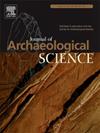检查玛雅蓝的热合成条件:洞察颜色,稳定性和粘土染料的相互作用
IF 2.6
1区 地球科学
Q1 ANTHROPOLOGY
引用次数: 0
摘要
玛雅蓝可以通过加热靛蓝和坡缕石的混合物来合成,但制备条件对其性质的影响尚不完全清楚。本研究考察了加热温度(100-500℃)和持续时间(1-72 h)对玛雅蓝的颜色、耐酸性、耐溶剂性和光稳定性的影响,以及颜料的结构和靛蓝-坡纹石的相互作用。反射率光谱和CIE颜色参数表明,玛雅蓝的最佳合成温度在100 ~ 200℃之间,建议加热时间不超过8 h。升高温度(高达200℃)可以增强绿色色调,同时降低蓝色色调;然而,温度超过200°C会导致显着的色彩饱和度损失。在150℃时,延长加热时间增加了绿色色相,但在8 h后保持稳定,蓝色色相相应减少。比表面积、微孔体积和x射线衍射结果表明,靛蓝分子在加热下深入渗透到坡纹石通道中。红外光谱表明,靛蓝与坡缕石之间的相互作用较弱,靛蓝通过分子内氢键被包裹成稳定的单体,这使得玛雅蓝呈现出绿蓝色的色调和优异的稳定性。高分辨率透射电子显微镜图像证实了玛雅蓝和原始坡缕石的相同微观结构。这些发现有助于加深对玛雅蓝制备机理的认识,并有助于有机-无机杂化材料的发展。本文章由计算机程序翻译,如有差异,请以英文原文为准。
Examining the thermal synthesis conditions of Maya blue: Insights into colors, stability and clay-dye interactions
Maya blue can be synthesized by heating a mixture of indigo and palygorskite, yet the impact of preparation conditions on its properties is not fully understood. This study investigates the effects of heating temperature (100–500 °C) and duration (1–72 h) on the color, acid resistance, solvent resistance, and photostability of Maya blue, as well as the pigment's structure and the indigo-palygorskite interaction. The reflectance spectra and CIE color parameters indicate that the optimal synthesis temperature for Maya blue lies between 100 and 200 °C, with a recommended heating time not exceeding 8 h. Increasing the temperature (up to 200 °C) enhances the green hue while diminishing the blue hue; however, temperatures above 200 °C result in significant color saturation loss. At 150 °C, extending the heating duration increases the green hue while maintaining stability after 8 h, with a corresponding reduction in the blue hue. The specific surface area, micropore volume, and X-ray diffraction results suggest that indigo molecules diffuse deeply into the palygorskite channels under heating. The infrared spectra indicate that the interaction between indigo and palygorskite appears weak, with indigo being encapsulated as stabilized monomers through intramolecular hydrogen bonding, which contributes to the greenish-blue hue and exceptional stability of Maya blue. High-resolution transmission electron microscope images confirmed the identical microstructure of Maya blue and raw palygorskite. These findings enhance the understanding of Maya blue’ preparation mechanism and may contribute to the development of organic-inorganic hybrid materials.
求助全文
通过发布文献求助,成功后即可免费获取论文全文。
去求助
来源期刊

Journal of Archaeological Science
地学-地球科学综合
CiteScore
6.10
自引率
7.10%
发文量
112
审稿时长
49 days
期刊介绍:
The Journal of Archaeological Science is aimed at archaeologists and scientists with particular interests in advancing the development and application of scientific techniques and methodologies to all areas of archaeology. This established monthly journal publishes focus articles, original research papers and major review articles, of wide archaeological significance. The journal provides an international forum for archaeologists and scientists from widely different scientific backgrounds who share a common interest in developing and applying scientific methods to inform major debates through improving the quality and reliability of scientific information derived from archaeological research.
 求助内容:
求助内容: 应助结果提醒方式:
应助结果提醒方式:


